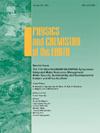基于热红外光谱成像的实地污染气体远程检测
IF 3
3区 地球科学
Q2 GEOSCIENCES, MULTIDISCIPLINARY
引用次数: 0
摘要
本文报告了长波红外遥感领域的新进展,重点介绍了窗口扫描时空调制傅立叶光谱成像技术的实现过程。利用自主研发的 CHIPED-1 设备,通过锥镜迈克尔逊干涉仪实现了空间调制干涉。通过将其与冷却的长波红外焦平面探测器组件相结合,并应用采集、重组、校准等数据处理步骤,实现了长波红外区域的高光谱分辨率成像。自主研发的CHIPED-1长波红外高光谱成像原理实验装置的单像素探测灵敏度指数nesr(噪声等效光谱辐射度)达到5.6×10-8w/(cm-1.sr.cm2),与商用时间调制干涉高光谱成像仪相当,体现了技术的进步性,并有很大的提升空间。通过测试聚丙烯薄膜的透射率曲线,CHIPED-1 红外高光谱成像原理实验装置的光谱响应范围达到 11.5 μm。文章还以野外高层建筑和乙醚气体的检测实验为例,研究了二维分布式化学气体 VOC 的高光谱成像检测方法。在复杂背景和低实验浓度下,无法从同波数的红外光谱切片中观察到乙醚蒸汽的存在。高光谱方法应用于有机挥发性有机物的红外检测领域,与宽波段热成像方法相比,具有灵敏度高、抗干扰能力强、识别范围广等诸多优点。本文章由计算机程序翻译,如有差异,请以英文原文为准。
Remote detection of polluted gases based on thermal infrared spectral imaging in the field
This paper reports the new progress of long wave infrared remote sensing in the field, focusing on the implementation process of window scanning spatiotemporal modulation Fourier spectroscopic imaging technology. Utilizing the self-developed CHIPED-1 device, the spatial modulation interference was achieved through the use of a cone mirror Michelson interferometer. By combining it with a cooled long-wave infrared focal plane detector component and applying data processing steps such as acquisition, recombination, calibration, etc., high-spectral resolution imaging in long-wave infrared region was accomplished. The detection sensitivity index nesr (Noise Equivalent Spectral Radiance) of the self-developed CHIPED-1 long wave infrared hyperspectral imaging principle experimental device reaches 5.6 × 10−8w/(cm−1.sr.cm2) in single pixel,Equivalent to commercial time modulation interferometric hyperspectral imagers; It reflects the progressiveness of the technology, and leaves much room for improvement.By testing the transmittance curve of polypropylene film, the spectral response range of CHIPED-1 infrared hyperspectral imaging principle experimental device reached 11.5 μm.The article also studied the hyperspectral imaging detection method for two-dimensional distributed chemical gas VOCs, taking the detection experiments of field high-rise buildings and ether gas as examples.Under complex backgrounds and low experimental concentrations, the presence of ether vapor cannot be observed from the infrared spectrum slices at the same wave number. However, after differential spectral processing, the spatial distribution of ether vapor can be clearly seen.The hyperspectral method is applied in the field of infrared detection of organic vapor VOCs, which has many advantages over wide-band thermal imaging methods, such as high sensitivity, strong anti-interference ability, and wide recognition range.
求助全文
通过发布文献求助,成功后即可免费获取论文全文。
去求助
来源期刊

Physics and Chemistry of the Earth
地学-地球科学综合
CiteScore
5.40
自引率
2.70%
发文量
176
审稿时长
31.6 weeks
期刊介绍:
Physics and Chemistry of the Earth is an international interdisciplinary journal for the rapid publication of collections of refereed communications in separate thematic issues, either stemming from scientific meetings, or, especially compiled for the occasion. There is no restriction on the length of articles published in the journal. Physics and Chemistry of the Earth incorporates the separate Parts A, B and C which existed until the end of 2001.
Please note: the Editors are unable to consider submissions that are not invited or linked to a thematic issue. Please do not submit unsolicited papers.
The journal covers the following subject areas:
-Solid Earth and Geodesy:
(geology, geochemistry, tectonophysics, seismology, volcanology, palaeomagnetism and rock magnetism, electromagnetism and potential fields, marine and environmental geosciences as well as geodesy).
-Hydrology, Oceans and Atmosphere:
(hydrology and water resources research, engineering and management, oceanography and oceanic chemistry, shelf, sea, lake and river sciences, meteorology and atmospheric sciences incl. chemistry as well as climatology and glaciology).
-Solar-Terrestrial and Planetary Science:
(solar, heliospheric and solar-planetary sciences, geology, geophysics and atmospheric sciences of planets, satellites and small bodies as well as cosmochemistry and exobiology).
 求助内容:
求助内容: 应助结果提醒方式:
应助结果提醒方式:


